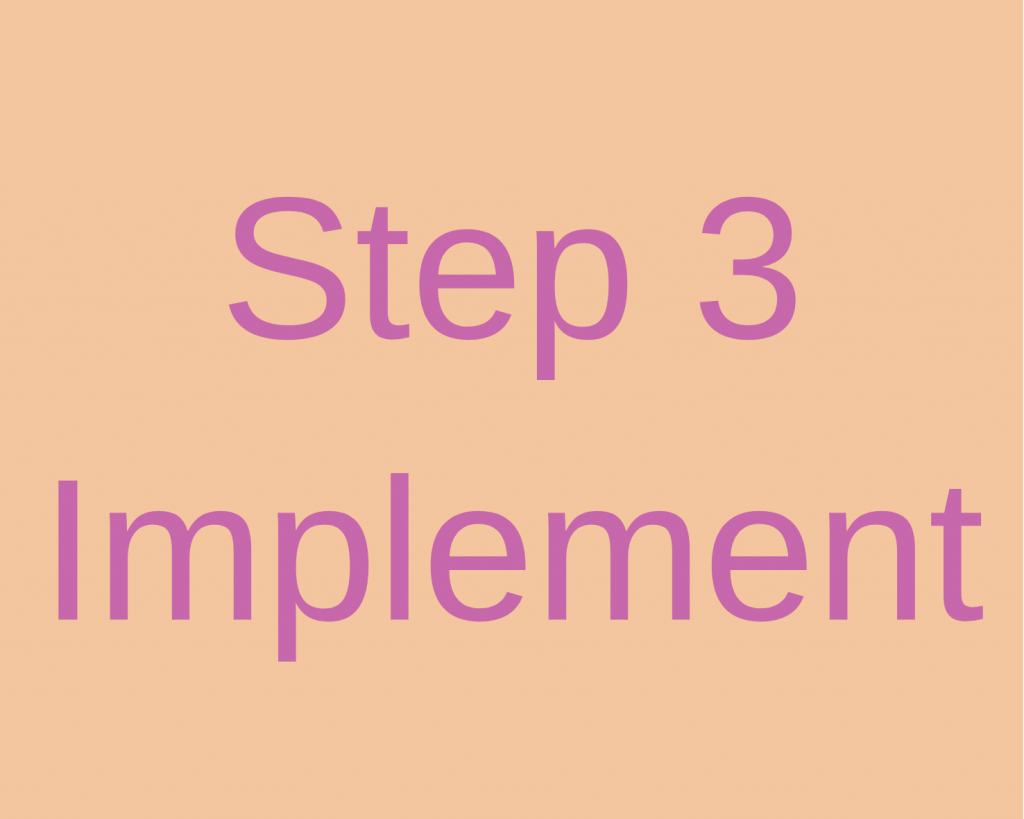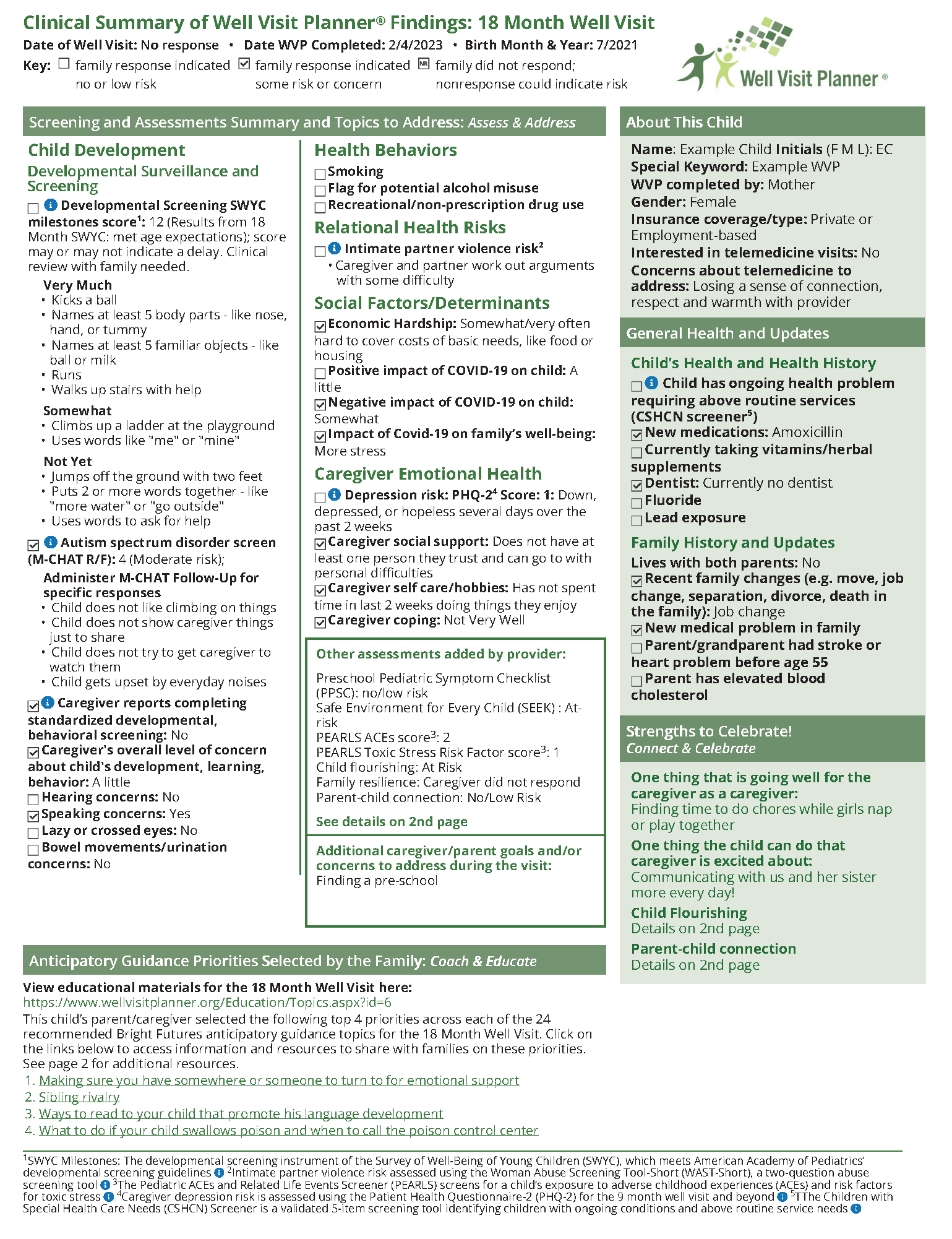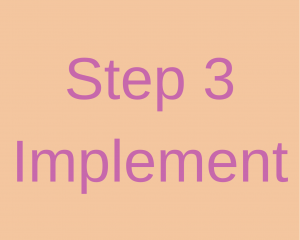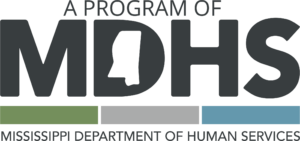Introduction
Health care providers who work with infants, toddlers, and preschoolers have a critical role to play in laying the foundation for early brain development, which has a lifelong effect on health and wellbeing. This toolkit offers practical resources for health care providers who are looking to incorporate recommended developmental screenings and provide comprehensive well child care services (WCC). Resources included can enhance the ways you equip parents and other caregivers to promote their children’s development. The visual map to this toolkit at the top of this page allows you to quickly access each resource by clicking on the boxes shown. We suggest you review the information below to learn more about featured resources before deciding which you wish to use in your practice. If you already know what you want to focus on, just click the boxes in the visual above to get started.
This toolkit is flexible and credible. Whether you are just beginning to implement developmental screenings and health promotion into your practice or, you are looking to make your existing approach more efficient and effective, this toolkit has something for you. The toolkit includes high-quality information from trustworthy sources, checklists and self-assessments, and guidance to help you integrate developmental screening services into your day-to-day practice. Ultimately, this toolkit will help you improve both your clinical efficiency and your clinical outcomes while improving the well-being of children and families.
This toolkit is aligned with national Bright Futures Guidelines: As portrayed in the visual map of this toolkit above, in addition to developmental screening, the toolkit offers approaches to implement a more comprehensive and transformative change in the way you deliver WCC using a set of health promotion resources, like Reach Out and Read as well as a comprehensive screening and whole child and family health promotion model called the Cycle of Engagement Well Visit Planner (COE/WVP) approach, each of which are aligned with national Bright Futures Guidelines. These approaches are evidence-based. The COE/WVP offers a model and set of digital tools you can use for free to ensure comprehensive screening and health promotion is provided based on the unique needs and priorities of each child and family. The Well Visit Planner (WVP) is carefully aligned with Bright Futures Guidelines for each age visit from the first week of life to age six and produces an easy-to-read Clinical Summary for providers and Well Visit Guide for families to use to prepare for and conduct personalized, connected encounters. Click here for a short video about the Cycle of Engagement Well Visit Planner approach (COE/WVP) and click on the COE/WVP box above for more information.
This toolkit can help you move toward a whole child and family, integrated health system approach. The tools offered in this toolkit are part of a larger vision for helping providers and families have the supports needed to ensure that children and families are engaged and successfully connected to necessary resources as early as possible when needs are identified. Ideally, practices are connected to care-coordination resources and are part of a strong and comprehensive early childhood system able to address their developmental, physical, social, and relational health needs. We invite you to explore the Engagement in Action Framework to learn about an integrated early childhood health system approach that helps you to partner with community and family-based resources as you address child development, social determinants and other health risks and needs of the children and families you serve.
A. DEVELOPMENTAL SCREENING
When we incorporate validated, reliable developmental screening tools into our work with families with young children, we are better able to identify and address mild delays that might be easily overlooked with only routine surveillance.
And when providers combine developmental surveillance and developmental screening, the likelihood of identifying a developmental delay or behavioral concern increases by up to 90%.
Identifying a problem early lets us refer our patients to an appropriate intervention sooner when it is most effective.
If you are looking for ways that your clinical practice can have a greater impact on the lives of your young patients, this toolkit is for you. It will help you to build a streamlined system to spot developmental concerns more reliably, select an intervention, and connect families with the right supports and services.
For practices that already conduct developmental screening, these recommendations may help you make your established processes more efficient. For practices just beginning to implement developmental screening, this toolkit walks you through a step-by-step process for designing a workflow and plan based on your individual needs and capabilities.
If you are a physician seeking to qualify for the American Board of Pediatrics, you can use sections of this toolkit to develop a Quality Improvement Project (MOC-4 project) focused on improving developmental screening.
Developmental Surveillance and Developmental Screening:
What's the Difference?
Surveillance is the ongoing, developmental monitoring that occurs at every well-child check. Noting whether a child is reaching developmental milestones and asking parents if they have concerns are components of surveillance. Developmental screenings are different in that they must take place using a validated tool and are performed at specific intervals.
At the 4- to 5-year well-child visit, when children are headed into kindergarten, special attention to surveillance is recommended and a developmental screen is suggested but not required unless a concern presents.
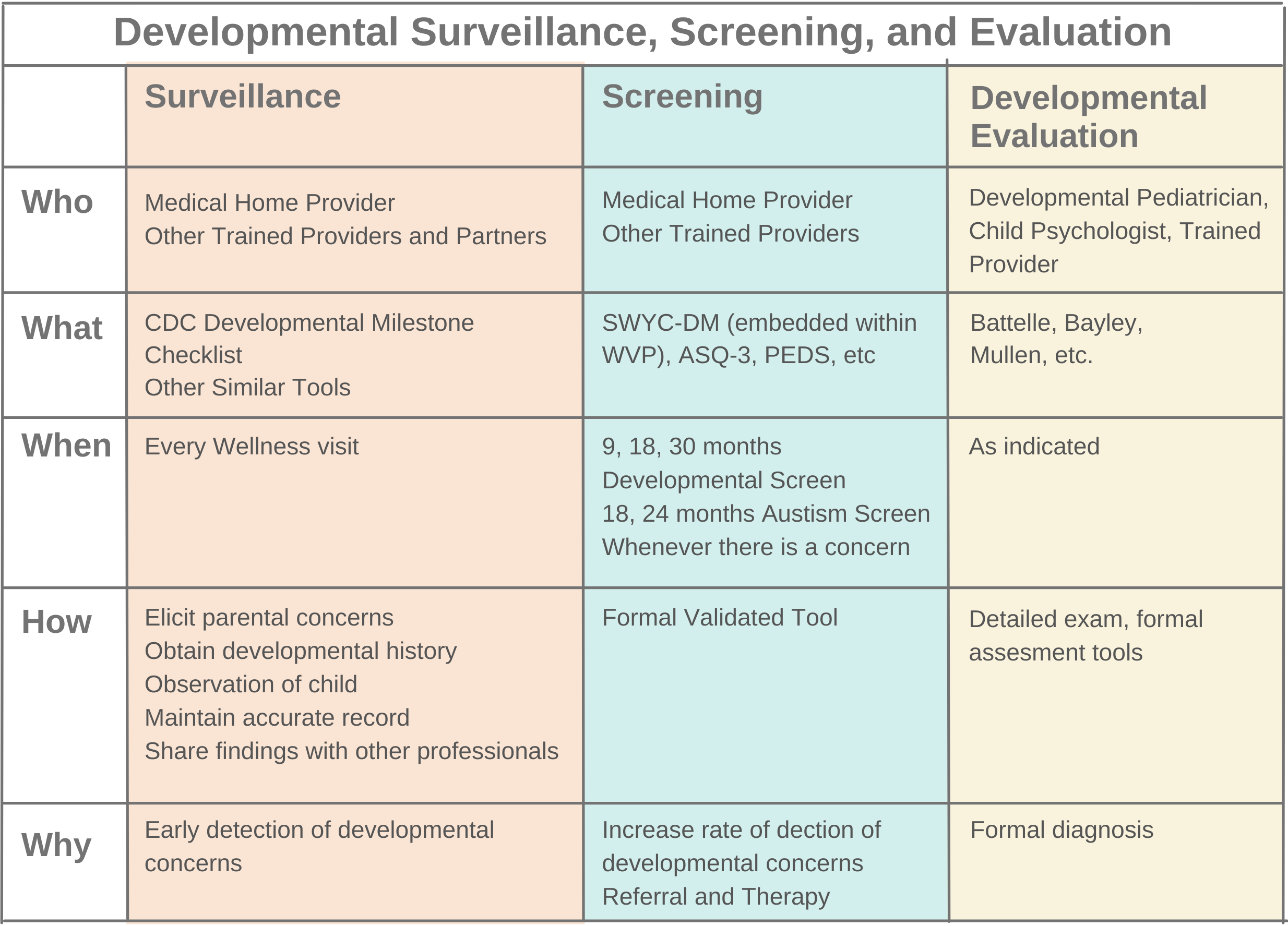
*Note: The Well Visit Planner incorporates surveillance.
Developmental Surveillance Resources for Healthcare Providers | CDC
Developmental Surveillance and Screening Patient Care (aap.org)
Screening for Professionals | CDC
When to Screen
The Bright Futures Program maintains and shares clinical guidelines that are age specific, based on the best available scientific evidence, and help increase the quality of primary and preventive care.
All children should receive services that follow Bright Futures periodicity schedule and include full implementation of Bright Futures.
Recommended Timing and Frequency of Developmental and Maternal Depression Screenings
This table outlines recommended screening periodicity (timing and frequency) for three screening domains (development, autism, and perinatal and postpartum depression) based on a child’s age months. These are baseline recommendations. If risk factors, provider concerns, or parental concerns arise, screening beyond what is outlined in the guidelines should occur.
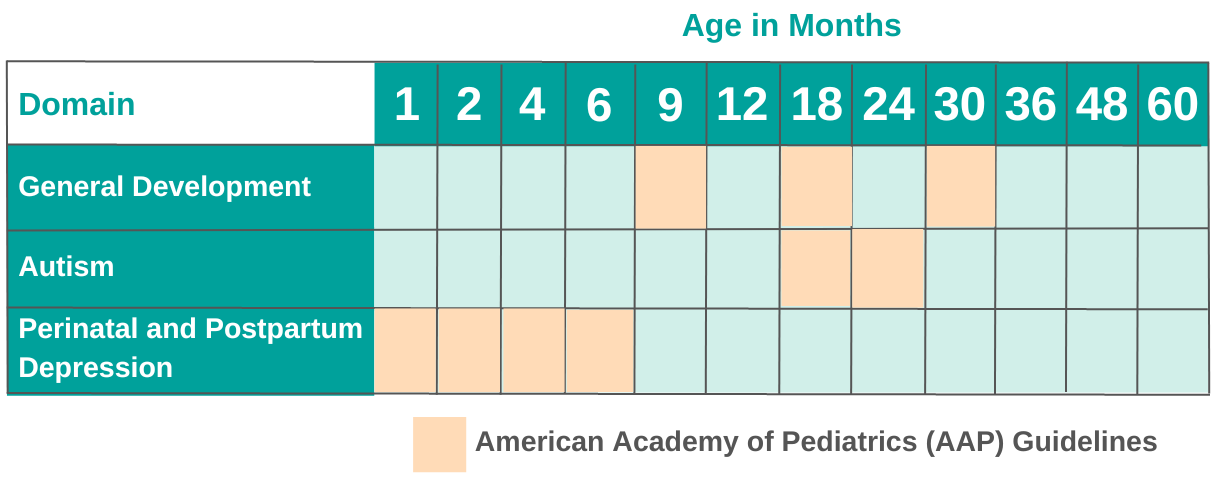
Option
A more comprehensive screening approach, that includes the above along with assessments for family health, child physical health, social determinants of health, social emotional development, family strengths and much more is what is recommended as standard of care as set forth in Bright Futures Guidelines and you are strongly encouraged to work towards this whole child and family approach. We know that doing so in a busy practice can be challenging and that current data shows that there are big gaps in implementation.
The Cycle of Engagement Well Visit Planner approach featured in this toolkit addresses many documented challenges to full implementation of Bright Futures. See this video to learn more or by visit this website. As noted above, the Well Visit Planner is meticulously aligned with Bright Futures Guidelines for each age visit and provides you with an “at a glance” Clinical Summary with resources tailored to the unique needs and priorities of each child and family (see illustration below).
Common, Evidence Based Developmental Screening Instruments
Identify which instrument(s) is/are the best fit for you practice/population.
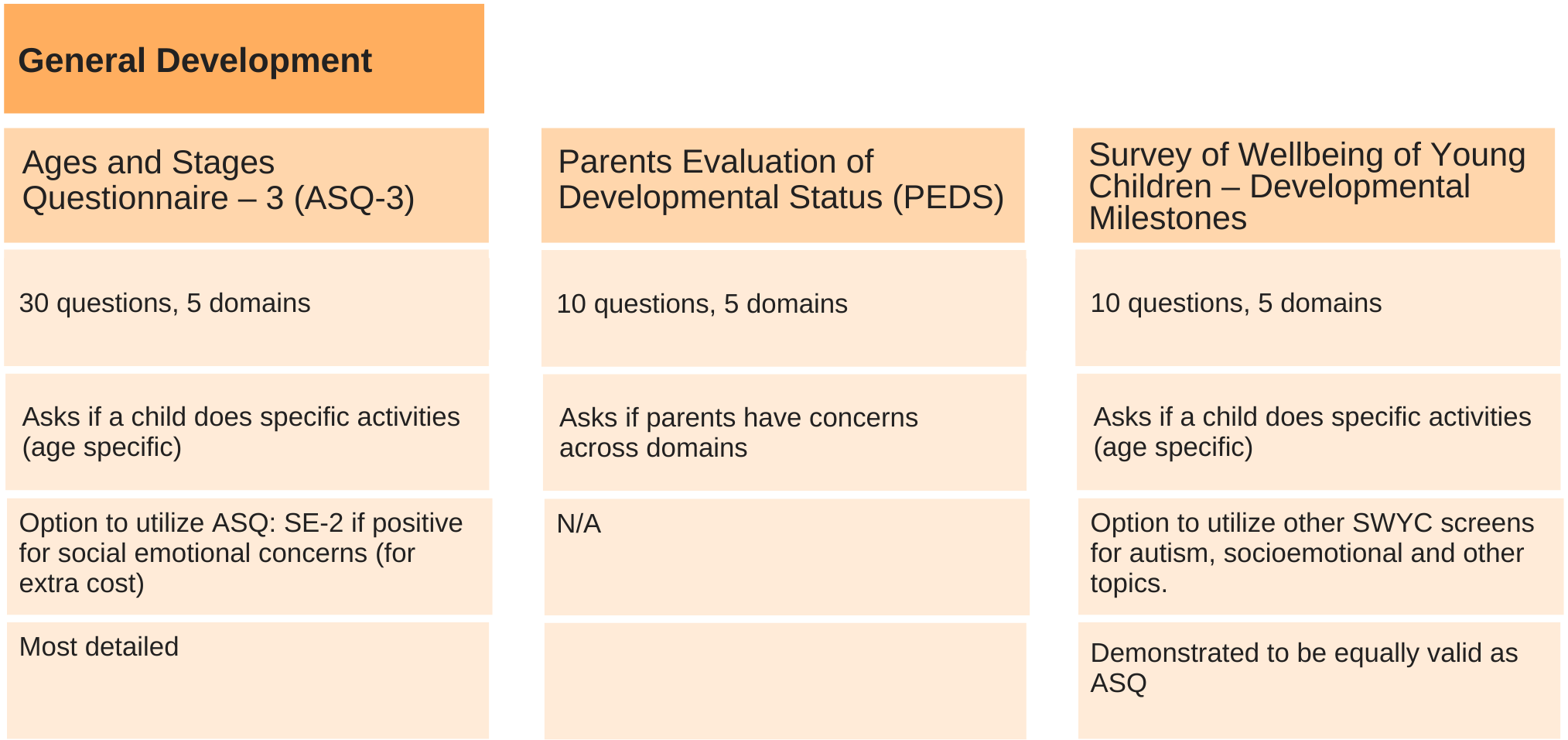
Click here to review a paper comparing these three screening instruments: Comparative Accuracy of Developmental Screening Questionnaires – PubMed (nih.gov)

Developmental Screening Toolkit Steps
Referrals & Resources
Referral resources are available for further evaluation, and intervention to address screening results that indicate concerns or delays. Resources are also available preventively, to promote healthy development. Resources for developmental screening and health promotion can be found here.
B. Developmental Health Promotion
Families play a significant role in fostering children’s developmental and behavioral health. Developmental health promotion is the process of equipping families to engage in relationships, activities and behaviors with their child that improve overall developmental health and quality of life.
When you actively promote developmental health with families, you help to foster a stronger parent-child bond, which builds a child’s capacity for strong relationships and establishes sturdy brain architecture. By integrating health promotion into every family’s care plan, you can help to mitigate external conditions that might negatively influence a child’s health, such as adverse childhood experiences in the home, financial instability, unhealthy neighborhoods or housing conditions, or other “social determinants of health.”
Many strategies or programs are available to help you promote early developmental health and to equip families as “brain builders” who can support healthy development. In addition, there are many high-quality, evidence-based resources available to share with families directly. Mississippi Thrive! encourages you to integrate and share health promotion materials and implement evidence-based strategies that reach all children, like those suggested in Primary Care Interventions for Early Childhood Development: A Systematic Review | Pediatrics | American Academy of Pediatrics (aap.org) and Preventing Childhood Toxic Stress: Partnering With Families and Communities to Promote Relational Health | Pediatrics | American Academy of Pediatrics (aap.org).
This toolkit features specific examples of health promotion strategies and resources to integrate into your practice.
- Reach Out and Read protocols to use with families
- Vroom digital app providing parent education information
- Wellness packets featuring family facing information about developmental screening and child health
- Well Visit Planner (WVP) digitally available family resource sheets for each anticipatory guidance and risk topic recommended in Bright Futures Guidelines. You can access and use these whether you use the WVP or not.
About This Resource
The overarching goal of the Child Health and Development Project (Mississippi Thrive!) has been to improve developmental health outcomes for young children through the building of a statewide developmental and behavioral health system. As part of the system build MST worked with health care providers to increase developmental screenings, connect more children to the services they need, and equip providers with materials and resources to promote developmental and behavioral health with caregivers at wellness visits. Additional work was conducted to advance more comprehensive, family-engaged, whole child approaches.
This toolkit provides information about the specific resources and approaches used to support health care providers at the University of Mississippi Medical Center to integrate developmental screening and additional approaches to engage families and conduct comprehensive screening and personalized health promotion into their pediatric practices as well as lessons learned. It was modeled after the Louisiana Developmental Screening Toolkit created by the Developmental Screening Initiative at the Louisiana Bureau of Family Health. It incorporates a Continuous Quality Improvement framework based on the clinical practice guidelines form the American Academy of Pediatrics.
This toolkit was developed by the Mississippi Thrive! Enhanced Pediatric Medical Home Services (EPMHS) team in partnership with The Child and Adolescent Health Measurement Initiative (CAHMI). The Child Health and Development Project: Mississippi Thrive! (CHDP) was a project of the University of Mississippi Medical Center’s (UMMC) Center for the Advancement of Youth (CAY) and the Social Science Research Center (SSRC) of Mississippi State University (MSU).
This project was supported by the Health Resources and Services Administration (HRSA) of the U.S. Department of Health and Human Services (HHS) as part of an award totaling $17.4 million with 0 percent financed with non-governmental sources. The contents are those of the author(s) and do not necessarily represent the official views of, nor an endorsement, by HRSA, HHS, or the U.S. Government. For more information, please visit HRSA.gov today. The Child and Adolescent Health Measurement Initiative (CAHMI) is a national non-profit initiative founded in 1996 to promote the early and lifelong health of children, youth and families using family-centered health and health care quality data and improvement tools and research. The Cycle of Engagement Well Visit Planner approach was developed and is maintained by the Child and Adolescent Health Measurement Initiative (CAHMI).





